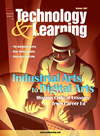 Welcome Technology & Learning readers. My article Getting It Wrong – Slaying Myths About Video Games covers 5 misconceptions many teachers about video games and was published in two parts in September and October.
Welcome Technology & Learning readers. My article Getting It Wrong – Slaying Myths About Video Games covers 5 misconceptions many teachers about video games and was published in two parts in September and October.
If you are interested in learning more in on the topic of games in the classroom here are two resources to help you.
John Rice’s Education Games Research is essential reading on the subject. John is a Technology Director for a School District here in Texas and has published research in this arena. He writes from a practitioner’s perspective but also with a good eye for research validation.
 The Education Business Blog
The Education Business Blog



 Teaching metaphors, the role of school in society, bad (i.e. wrong) press for video games, glitz vs. content, banned books, racism in games, phishing games, and monkeys at the keyboard. All featured on this weeks roundup!
Teaching metaphors, the role of school in society, bad (i.e. wrong) press for video games, glitz vs. content, banned books, racism in games, phishing games, and monkeys at the keyboard. All featured on this weeks roundup!
 It got a nice review on John Rice’s
It got a nice review on John Rice’s  First off, I find it interesting that Second Life is getting most of the visibility in Education when other virtual worlds (Habbo Hotel, Whyville, etc.) are doing far more with K12 age kids and some have more intentionally educational content on them. Chalk it up to Second Life being a media darling and to good outreach from their Education team. If you are interested in this arena some of these other worlds merit a look.
First off, I find it interesting that Second Life is getting most of the visibility in Education when other virtual worlds (Habbo Hotel, Whyville, etc.) are doing far more with K12 age kids and some have more intentionally educational content on them. Chalk it up to Second Life being a media darling and to good outreach from their Education team. If you are interested in this arena some of these other worlds merit a look. The panel on Managing Influencers at the Austin Game Developers Conference yesterday got me thinking about a frequently ignored aspect of the K12 publishing world – building and nurturing communities of key influencers around education products.
The panel on Managing Influencers at the Austin Game Developers Conference yesterday got me thinking about a frequently ignored aspect of the K12 publishing world – building and nurturing communities of key influencers around education products. Blizzard matters to education because when you strip away the Orcs and Elves under the hood they have built an extremely elegant learning management system. As the undisputed world wide leader in the
Blizzard matters to education because when you strip away the Orcs and Elves under the hood they have built an extremely elegant learning management system. As the undisputed world wide leader in the